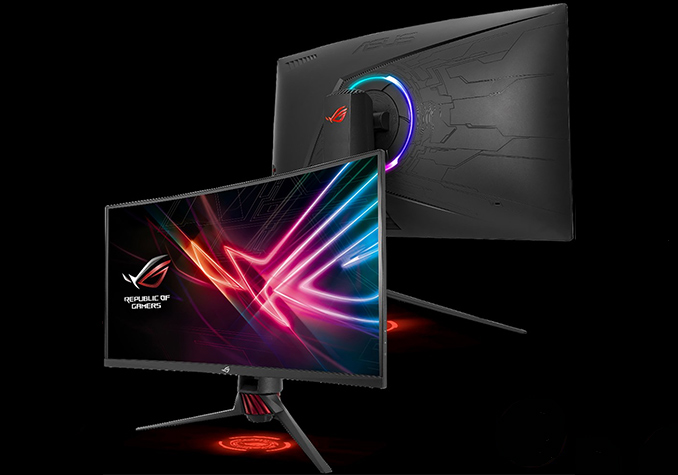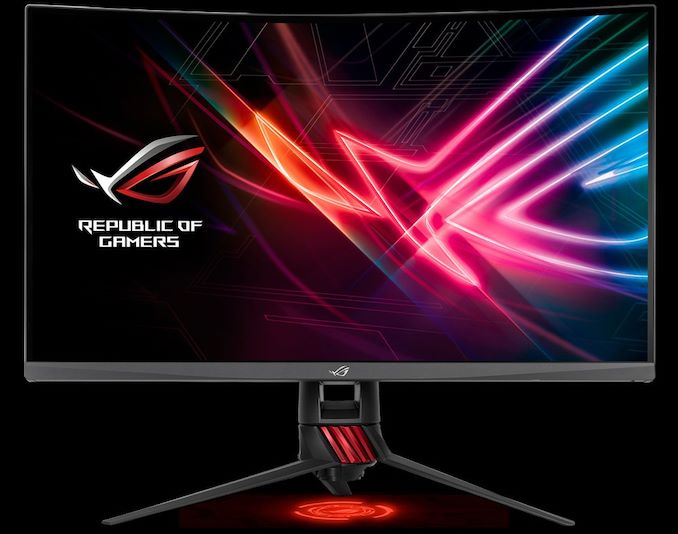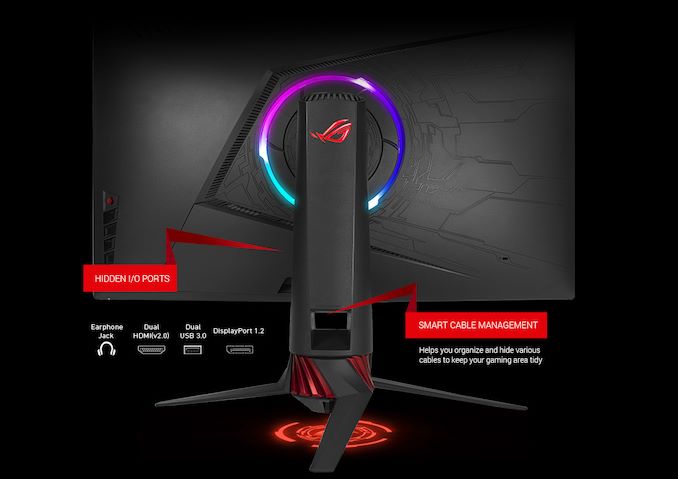ASUS Lists ROG Strix XG32VQR Curved FreeSync 2 Display with RGB
by Anton Shilov on November 30, 2018 3:00 PM EST
ASUS has quietly added its first AMD FreeSync 2-supporting monitor to its lineup. The ROG Strix XG32VQR is a large curved display boasting with a 144 Hz maximum refresh rate, the DisplayHDR 400 badge, and is capable of covering 94% of the the DCI-P3 color gamut. The LCD will be the sixth FreeSync 2 monitor on the market, so it will have only a limited number of competitors. Meanwhile, one of its ways to attract attention of gamers will be its Aura Sync RGB lighting.
Specifications of the ASUS ROG Strix XG32VQR are generally similar to specs of other FreeSync 2 displays introduced by competing manufacturers this year, but there are a number of important improvements that the ASUS product offers. The monitor uses a 31.5-inch curved VA panel featuring a 2560×1440 resolution, 450 nits brightness (by contrast, competing displays only offer 400 nits brightness), a 3000:1 contrast ratio, 178°/178° viewing angles, a 4 ms response time, and a 144 Hz maximum refresh rate. The LCD can reproduce 94% of the DCI-P3 color gamut as well as 125% of the sRGB color space (keep in mind that everything higher than 100% in case of color spaces is a rather uncertain advantage).
Meanwhile, the main features of the ROG Strix XG32VQR are AMD’s FreeSync 2 dynamic refresh rate technology with Low Framerate Compensation tech as well as the DisplayHDR 400 badge. The FreeSync 2 range that ASUS offers is between 48 Hz and 144 Hz, which is broader than that offered by competing displays supporting the tech (from 72 Hz to 144 Hz).
Speaking of competitors, it is necessary to note that apart from higher luminance and broader FS2 range, the ROG Strix XG32VQR features ASUS Aura RGB lighting on the back as well as an LED-based ROG signature on the bottom. RGB and lighting effects are quite trendy among gaming community these days, so these features will clearly attract attention of the target audience.
Other capabilities that will be appreciated by gamers include firmware-based GamePlus and GameVisual technologies that add elements like crosshair or FPS counter as well as adjust brightness and contrast settings for particular game genres.
Moving on to connectivity, the display is equipped with DisplayPort 1.2, Mini DisplayPort 1.2, and HDMI 2.0 inputs. The monitor also sporots a dual-port USB 3.0 hub and a headphone jack. In addition, the monitor has an adjustable stand that can regulate height, tilt, and swivel.
ASUS has not announced pricing of the monitor or its availability timeframe. Considering the fact that a number of companies already offer similar devices, it is highly likely that the ROG Strix XG32VQR will hit the market sooner rather than later.
| The ASUS ROG Strix XG32VQR | |
| General Specifications | |
| Panel | 31.5" VA |
| Native Resolution | 2560 × 1440 |
| Maximum Refresh Rate | 144 Hz |
| Response Time | 4 ms GtG |
| Brightness | 450 cd/m² (peak) |
| Contrast | 3000:1 |
| Backlighting | LED |
| Viewing Angles | 178°/178° horizontal/vertical |
| Curvature | 1800R |
| Aspect Ratio | 16:9 |
| Color Gamut | 125% sRGB/BT.709 94% DCI-P3 |
| DisplayHDR Tier | 400 |
| Dynamic Refresh Rate Tech | AMD FreeSync 2 (48 - 144 Hz) |
| Pixel Pitch | 0.2767 mm² |
| Pixel Density | 91.79 PPI |
| Inputs | 1 × DisplayPort 1.2 2 × HDMI 2.0 |
| Audio | 3.5 mm output |
| USB Hub | 2 × USB 3.0 Type-A connectors 1 × USB 3.0 Type-C input |
| Stand Adjustments | Height: ±100 mm Tilt: -5˚ - 20˚ Swivel: -50˚ - 50˚ |
| MSRP | unknown |
Related Reading:
- BenQ Unveils EX3203R 32-inch Curved LCD with FreeSync 2, DCI-P3, & USB-C
- AOC Announces AGON AG322QC4 32-Inch Curved LCD with FreeSync 2 & DisplayHDR 400
- Samsung Announces First Freesync 2 Monitors: CHG70 & CHG90 - Quantum Dots, Up to 49”, 144 Hz, DCI-P3
- AMD Announces FreeSync 2: Easier & Lower Latency HDR Gaming
Source: ASUS (via Tom’s Hardware)













21 Comments
View All Comments
Inteli - Friday, November 30, 2018 - link
Freesync is royalty-free, where GSync requires proprietary hardware on the display side. Freesync is also part of the DisplayPort 1.2 standard, while GSync isn't. Is it really that surprising?jordanclock - Friday, November 30, 2018 - link
Yeah, to go from DP1.2 certification to FreeSync isn't much, but being able to slap that name on the box is probably a good driver of sales, if only to avoid being the only monitor in a given segment that doesn't have some sort of variable refresh option.DPete27 - Friday, November 30, 2018 - link
After recently wading into the cesspool that is TomsHardware forums, I've been amazed at the almost ubiquitous endorsement of Nvidia GPUs of all levels of performance with no regard to value (price/performance). Given that, I have a better understanding for why Nvidia has the abnormally large market share they do.Spunjji - Sunday, December 2, 2018 - link
This x1000. Poor arguments, circular justifications and logical abominations abound. It's even worse on sites like WCCF.BurntMyBacon - Monday, December 3, 2018 - link
nVidia could decide at any time to support DP adaptive sync for their desktop cards (as they already do for G-Sync laptop displays). It is a known open standard and there are no license fees, royalties, or other barriers to entry for nVidia. They have all the necessary hardware in place to support it on existing cards, they just need to enable it via software. Even though the monitors are branded FreeSync, the technology is still DP adaptive sync so that 95% of the VRR displays would be useful to nearly the entire market. Unfortunately, the same cannot be said about G-Sync monitors. Even in the unlikely event that nVidia decided to allow AMD to create G-Sync compatible hardware, and the even more unlikely even that they decide not to charge for the access, only future cards would be able to implement the necessary changes to take advantage of it.HOSH - Friday, November 30, 2018 - link
I have to wonder where out G-Sync version of this one and another couple are, as even if they cost more, they are worth the difference.And yes agreed it is easy for them to get the DP 1.2 and then just the little more for the FreeSync, so it is something for them as an extra selling point.
Spunjji - Sunday, December 2, 2018 - link
"as even if they cost more, they are worth the difference"How?
DPete27 - Friday, November 30, 2018 - link
And which FS2 displays are 72-144Hz exactly?AFAIK, the only panel that is being used in FS2 displays are the Samsung curved VA panels inside the C32HG70 and C27HG70 which match the specs of this display exactly.
Jad77 - Saturday, December 1, 2018 - link
LG has similar 32" monitors, using flat VA panels. The Freesync 2 version can be bought for around $400. I can't find the LFC numbers so I don't know how this monitor competes.So is putting goofy LED's on the (unseen) backside of a monitor a thing now?
Jad77 - Saturday, December 1, 2018 - link
One preview reports the 32GK850F-B's Freesync range as 40 - 144Hz, LG hasn't posted the spec though.